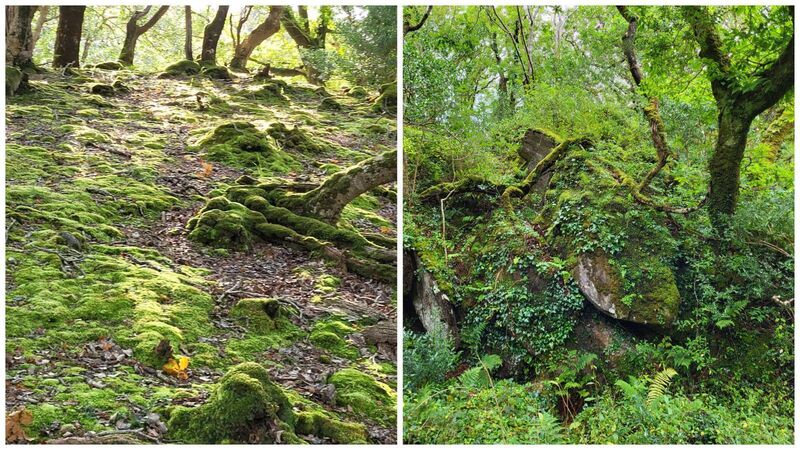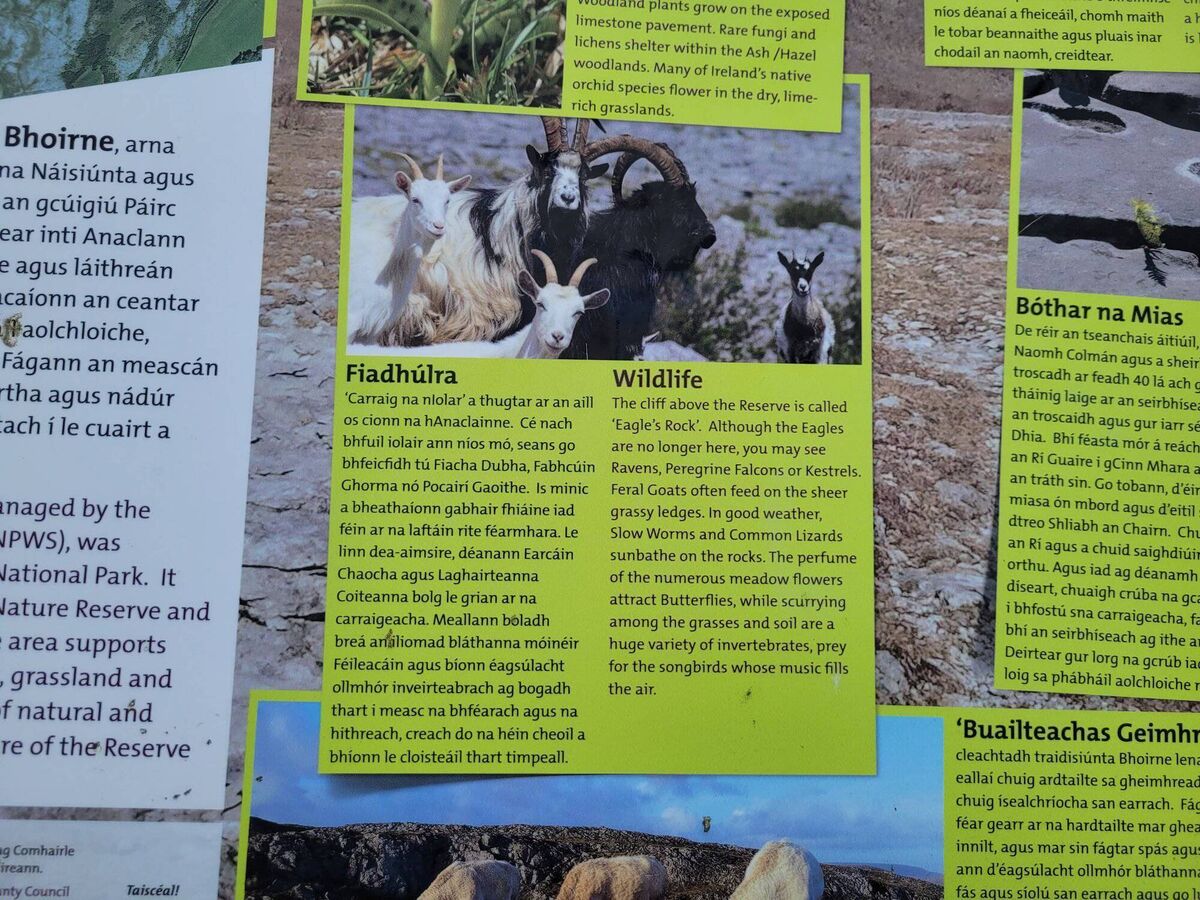Killarney’s dying rainforest: A towering national disgrace for more than 50 years

Left: severe overgrazing in Killarney National Park. Right: a healthy, non-overgrazed native rainforest - in West Cork Pictures: Eoghan Daltun
I have on my shelf a book titled , edited by the great Irish naturalist Éamon de Buitléar. On page 63, there’s an image of Tomies Wood in Killarney National Park, showing a stark contrast between two sides of a fence: one untouched by sika deer and other grazers, full of regenerating native trees and flora, and utter desolation outside.
was published in 1984, 40 years ago. But we know that, more than a decade before, in the early 1970s, ecologists were already flagging both the severe damage overgrazing was doing in the park, and the closely related problem of invasion by Rhododendron ponticum. Given that over half a century has since passed, that Killarney is easily Ireland’s most important surviving fragment of native forest, and that it’s in the ‘care’ of the State, these issues must surely have been resolved by now, you might reasonably imagine?
You’d be wrong. For more than 50 years, nothing has been done to alter the decline. In fact, the one campaign that was successfully tackling part of the problem — rhododendron — was, according to those involved, essentially scuppered by park authorities.
For more than three decades, Groundwork ran a rhododendron clearance programme in Killarney, with thousands of volunteers coming from all over the world and helping to completely rid the plant from almost 900 acres of the most ecologically valuable parts of the park. That equates to around 500 football pitches of extremely rare and valuable habitat. Equally importantly, it was afterwards kept rhodo-free with periodic systematic sweeps, pulling any seedlings that had since arrived. Combining deep passion with an experience-based scientific methodology, it was the most effective ecological restoration campaign this country has ever seen.
Yet, from what I understand, for inexcusable, cynical reasons I won’t delve into here, after 31 years their work was essentially rendered impossible by park authorities, and they were forced to withdraw. The result is that most of the cleared areas are reinfested with rhododendron, much of which is now, itself, flowering. That means it’s producing seed, and one bush can produce a million every single year. It would seriously make you want to weep.
CLIMATE & SUSTAINABILITY HUB
A very successful long weekend (3 days straight) cutting Rhodo in a Conamara woodland site. We made some amazing progress and great memories. An-chraic go deo agus an buíoch don gang go leir @RewildingIre @Groundwork9 pic.twitter.com/1l5ngaRnPc
— Rhodo Rangers (@RhodoRangers) April 28, 2024
But it’s important to understand that the rhodo is, in many respects, a symptom of the core problem: overgrazing. Once all native vegetation has been stripped away, the mosses that remain make a perfect bed for prolific germination of millions of rhododendron seeds, and the absence of native competition for light allows rapid subsequent growth. (The grazers won’t eat rhododendron because its leaves contain toxic chemicals.) But the overgrazing doesn’t only encourage takeover by rhododendron. With every oak or other native tree seedling that appears quickly eaten, the forest cannot regenerate, and so in Killarney has been dying away for more than half a century. The hugely rich and diverse ground flora of wildflowers, ferns, etc. that should be present is also completely cleaned out, leaving a barren, lifeless woodland floor.
What is causing this overgrazing? Primarily other non-native invasive species: sika deer, feral goats, and sheep. (There are also a few native red deer.) A natural characteristic of all herbivores is a rapid reproduction rate, vital to maintaining their numbers in the face of predation. But in Ireland, all larger native predators — lynx, wolves, bears — were driven to extinction by our ancestors, opening the way for exponential increases of deer and other grazers. Our neighbouring island, Britain, is experiencing the exact same problem, with deer numbers now estimated at around two million, the highest in 1,000 years.
Deer reproduce so quickly that roughly 40% must be culled annually just to prevent numbers expanding. Skyrocketing populations of sika deer are now a massive problem in many parts of Ireland, and not only for natural ecosystems: they also provoke frequent road accidents, spread tick-borne lyme disease, and impact society in a variety of other ways. Anyone who objects to deer being shot should consider that, aside from the thousands of other species that die off as ecosystems are devoured, the deer themselves end up suffering terribly from starvation, as they strip out all edible plants.
Feral goats near Mullaghmore today. Have seen some very big (60+) herds over that way.
— Ó Foghlú (@rayofoghlu) April 7, 2023
Whilst they are enthusiastic consumers of trees/bark/foliage they can't hold back the tide of "scrub" sweeping over the Burren. pic.twitter.com/gq5RPN2ku5
Given this context, and returning to Killarney, what is being done?
Responding to parliamentary questions from West Cork TD Christopher O’Sullivan in mid-April, the minister responsible, Malcolm Noonan, told us that over the last five years, 501 red deer and 461 sika were shot by National Parks and Wildlife Service personnel (nobody else is permitted). That tally for sika is utterly farcical, and indeed if you visit the park today, especially near dark, you’ll find it teeming with them. Note also that more (rare) native reds were shot than (proliferating) invasive sika: utter madness.

As for the invasive goats, in Killarney they aren’t being culled at all, just ‘monitored’. Per capita, no other grazer matches goats for sheer ecosystem destroying capacity: globally, ecologists call them ‘desert makers’. But in Ireland, this still hasn’t been grasped: mobs in their hundreds are allowed to freely kill off native habitat in the Burren National Park, and the information centre celebrates them as ‘wildlife’. You honestly couldn’t make up the stratospheric levels of ecological ineptitude on display.
As I have seen with my own place on the Beara Peninsula, it really doesn’t take much for a rainforest ecosystem to burst with diverse life once more: just remove the goats, sika, sheep, rhododendron, and any other invasive species. The result is a miraculous explosion of vibrant biodiversity. (See my book for more.)

The announcement by several Government ministers that the new national park, Páirc Náisiúnta na Mara on the Dingle Peninsula, will continue to be grazed by sheep shows that more than half a century of degradation in Killarney isn’t accidental, nor that of any of our other national parks. It’s the result of willful decisions at the top of the NPWS, department, and minister responsible to overlook what is causing the destruction, or do anything serious about it. And if our national parks are to remain overgrazed wrecks, just where, exactly, is wild nature supposed to exist, on an island that has essentially been turned into one big livestock farm?
We have two choices: either we start getting real about what is required to reverse one of the worst ecological collapses on the entire planet by acting on the science, which primarily means mass rewilding, or be responsible for the continued death spiral of Irish nature.
Which will it be?







